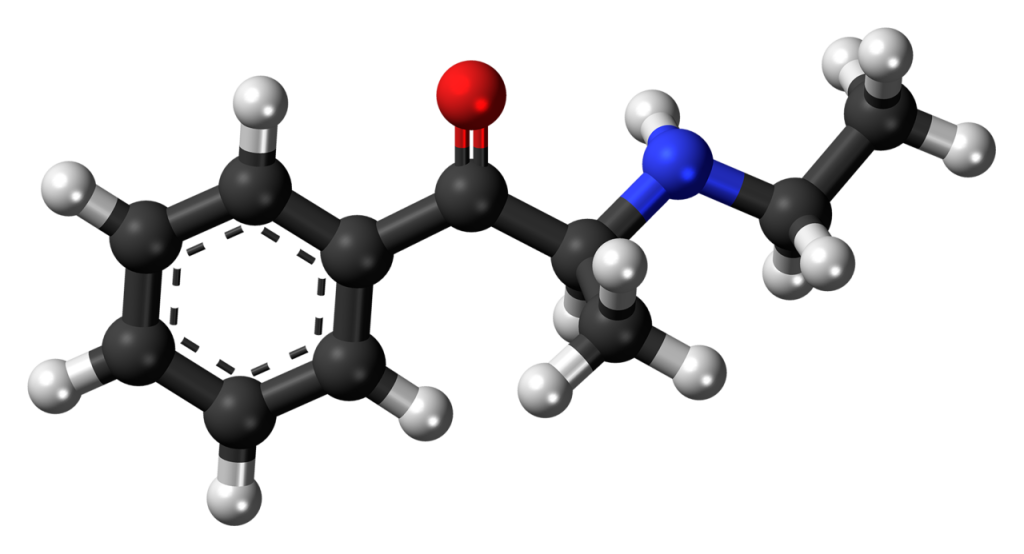Contents
- 1 Summary
- 2 Pharmacology
- 3 Legal status
- 4 FAQ
- 4.1 1. What is Ethcathinone?
- 4.2 2. Is Ethcathinone legal?
- 4.3 3. How does Ethcathinone work?
- 4.4 4. Is Ethcathinone related to other substances?
- 4.5 5. What are the effects of Ethcathinone?
- 4.6 6. Is Ethcathinone safe for human consumption?
- 4.7 7. Can Ethcathinone be detected in drug screenings?
- 4.8 8. What is the legal status of Ethcathinone in the United States?
- 4.9 9. How is Ethcathinone typically used?
- 4.10 10. Are there any health risks associated with Ethcathinone use?
- 5 References
Summary
Ethcathinone, also recognized by its aliases ethylpropion or ETH-CAT, belongs to the stimulant drug category encompassing the phenethylamine, amphetamine, and cathinone classes of chemicals. It plays a pivotal role as an active metabolite of the prodrug diethylcathinone and is exclusively accountable for producing its effects. Ethcathinone has been detected as a constituent in various quasi-legal “party pills.” Moreover, it has been reported, alongside mephedrone, to have been distributed under the guise of “ecstasy” in the Australian city of Cairns.
| Identifiers | |
|---|---|
| IUPAC name | |
| CAS Number | 18259-37-5 hydrochloride: 51553-17-4 |
|---|---|
| PubChem CID | 458519 |
| IUPHAR/BPS | 7398 |
| ChemSpider | 403504 |
| UNII | HV3BCK77BBhydrochloride: SQ59TT7X5R |
| CompTox Dashboard (EPA) | DTXSID70939595 |
| Chemical and physical data | |
| Formula | C11H15NO |
| Molar mass | 177.247 g·mol−1 |

Pharmacology
The pharmacological profile of ethcathinone was elucidated in a study conducted by Rothman and Baumann in 2006, where it was compared with other psychostimulants. Ethcathinone primarily operates through two predominant mechanisms: it serves as a moderately active noradrenaline releaser (with an EC50 value of 99.3nM), while its inhibition of dopamine reuptake is relatively weak (with a Ki value of 1,014nM).
Interestingly, the activation process of diethylcathinone, a prodrug, hinges on its conversion into ethcathinone through metabolism. This suggests a reasonable assumption that, upon consumption, ethcathinone might undergo N-dealkylation, transforming into the more potent cathinone, which robustly stimulates dopamine release. However, it’s worth noting that ethcathinone’s status as a prodrug is subject to debate. Unlike diethylcathinone, ethcathinone is already biologically active on its own, a characteristic shared with compounds like tramadol, codeine, and MDMA. Consequently, it may not universally fit the strict definition of a prodrug according to certain perspectives.

Legal status
Ethcathinone, in conjunction with mephedrone and mephedrone, faced prohibition in Denmark on December 18, 2008.
Starting from October 2015, China classified Ethcathinone as a controlled substance.
In the United States, this compound is prohibited due to its structural similarity to mephedrone as a positional isomer.
| Legal status | |
|---|---|
| Legal status | BR: Class F2 (Prohibited psychotropics)[2] DE: Anlage II (Authorized trade only, not prescriptible) UK: Class B US: Schedule I[1] |
FAQ
1. What is Ethcathinone?
Ethcathinone, also known as ethylpropion or ETH-CAT, is a stimulant drug that belongs to the phenethylamine, amphetamine, and cathinone chemical classes. It is chemically related to cathinone, a compound found in the khat plant.
2. Is Ethcathinone legal?
The legal status of Ethcathinone varies from country to country. It is considered a controlled substance in several places due to its psychoactive properties. It is crucial to research and understand the legal status of Ethcathinone in your area before attempting to purchase or possess it.
3. How does Ethcathinone work?
Ethcathinone primarily acts as a stimulant by affecting the release of neurotransmitters like noradrenaline and dopamine in the brain. It is known to be a moderate noradrenaline releaser and a weak dopamine reuptake inhibitor.
Yes, Ethcathinone is chemically related to cathinone, which is found in the khat plant. It is also related to other synthetic cathinones, such as mephedrone and mephedrone.
5. What are the effects of Ethcathinone?
The effects of Ethcathinone can include increased energy, alertness, and sociability. However, it can also lead to side effects such as anxiety, paranoia, and increased heart rate. The intensity and nature of effects can vary depending on the dose and individual tolerance.
6. Is Ethcathinone safe for human consumption?
Ethcathinone is not considered safe for human consumption. Its effects on humans are not well-documented, and it can be associated with various health risks, including addiction and adverse reactions.
7. Can Ethcathinone be detected in drug screenings?
Ethcathinone may not be included in standard drug tests. However, specialized tests that screen for synthetic cathinone may detect its presence if administered.
8. What is the legal status of Ethcathinone in the United States?
Ethcathinone is banned in the United States due to its structural similarity to mephedrone, a widely controlled substance.
9. How is Ethcathinone typically used?
Ethcathinone is not approved for human consumption and is primarily used for research purposes. Researchers may acquire it for scientific investigations and pharmacological studies.
10. Are there any health risks associated with Ethcathinone use?
Yes, there are potential health risks associated with Ethcathinone use, including anxiety, paranoia, increased heart rate, and the risk of addiction. Long-term effects and health consequences are not well understood due to limited research.
Please note that this information is provided for general knowledge and safety awareness. Always consult with a qualified professional and adhere to local laws and regulations when dealing with substances like Ethcathinone.
References
- DEA Controlled Substances Act Listing (21-Jul-15): On July 21, 2015, the U.S. Drug Enforcement Administration (DEA) made a significant listing under the Controlled Substances Act, which regulates various substances, including controlled drugs and substances.
- Anvisa Regulation (RDC Nº 804): The Brazilian Health Regulatory Agency (Anvisa) issued Regulation No. 804, which pertains to Lists of Narcotic, Psychotropic, Precursor, and Other Substances under Special Control. This regulation is aimed at controlling certain substances with psychoactive properties. It was published on July 24, 2023, in the Brazilian Portuguese “Diário Oficial da União” (Official Gazette).
- Chemical Analysis Study: A chemical analysis study conducted in April 2010 by Camilleri et al. examined four capsules containing controlled substance analogues, including 4-methylmethcathinone, 2-fluoromethamphetamine, alpha-phthalimidopropiophenone, and N-ethylcathinone.
- Concerns in Cairns: There were reports of “killer pills” hitting Cairns, Australia, though the source link is no longer available. The capsules in question contained potentially dangerous substances, raising concerns about their safety.
- Warning About Fake Ecstasy: Authorities issued warnings about potentially fatal “fake ecstasy” pills. These warnings highlight the risks associated with consuming substances that may not be what they appear to be.
- Therapeutic Potential Study: Rothman and Baumann’s study in 2006 explored the therapeutic potential of monoamine transporter substrates, shedding light on the pharmacological properties of such substances.
- Chinese Regulatory Notice: On September 27, 2015, the China Food and Drug Administration issued a regulatory notice (in Chinese) concerning the management of non-medical narcotic drugs and psychotropic drugs. This notice is significant for regulating certain substances in China.